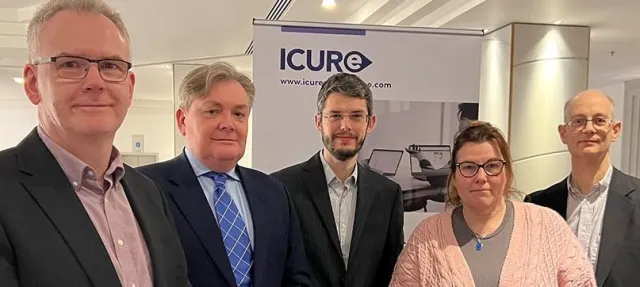A startup spurred by technology developed at Lancaster University in Lancaster, Lancashire, England, is putting its hat in the ring with a candidate to displace DRAM.
Formed in mid-February, UltraRAM’s technology is based on a novel type of memory invented by Lancaster physics professor Manus Hayne. It combines the speed, energy efficiency and endurance of working memory, such as DRAM, with the non-volatility of storage-class memory, such as NAND flash. UltraRAM exploits quantum resonant tunneling in compound semiconductor materials commonly used in photonic devices like LEDS, laser diodes and infrared detectors, Hayne told EE Times in a briefing.
As tried and true as DRAM is with its low switching energy and high endurance, one of its annoying drawbacks is that it’s volatile, Hayne said, and information is lost when the device is powered off.
“It’s actually constantly forgetting because the capacitor in the DRAM leaks and then it has to be refreshed every 60 ms, which is quite inefficient,” he said.
Conversely, flash is non-volatile and retains data, but it’s slow and wears out, Hayne noted. “You’ve got to have a lot of error correction and wear leveling to get around that.”
Together in the memory hierarchy, DRAM and flash work well, Hayne said, but there is always a desire to have a memory that combines the advantages of both without the disadvantages—a universal memory.
Lancaster University’s Marcus Hayne.
Lancaster University’s Manus Hayne
UltraRAM is not the first attempt at a universal memory—the most notable and recent being 3D XPoint, including Intel’s Optane, which is phase-change memory (PCM). There are many other emerging memories that have shown promise, but none have really succeeded, such as magnetoresistive random-access memory (MRAM) and ferroelectric random-access memory (FRAM), according to Hayne. The latter has been around for 70 years, but emerging memories occupy less than 1.4% of the market, he added.
“Although they’re non-volatile, like flash, they’re not as cheap as flash, so they can’t replace flash and the performance can’t outmatch DRAM.”
UltraRAM hopes to do both, he said, by virtue of being a compound version of flash that takes advantage of the characteristics of compound semiconductors, which are used in photonic devices. “By using the compound semiconductors, you can tune the properties of the material to get the functionality you can’t easily achieve in silicon.”
UltraRAM uses a group of compound semiconductors called the 6.1 Angstrom family, which ultimately allows it to eliminate the disadvantages of flash while still being a non-volatile device, Hayne said. “Because the resonant tunneling is low-voltage and the device is low-capacity, the switching energy is very low and the endurance is very high.”
After 10 million cycles, there’s no sign of damage, he added.
“The device can be extremely fast, and it has high endurance, so it’s a non-volatile device that has the potential to outperform DRAM.” This contrasts with emerging memories that Hayne said have not shown they can outpace DRAM. “Intrinsically, the performance isn’t actually as good.”
Ultimately, the emerging memories have gone the route of flash while still struggling to scale up to be cost-effective alternatives to either DRAM or flash in any significant way.
UltraRAM’s next task is to scale down, according to Hayne. Right now, the device is as large as 20 microns and has been made using optical lithography at Lancaster. The newly formed company is now using e-beam lithography and targeting 20 nm by the end of the year, which Hayne said is not far off from leading-edge DRAM. “We also plan to make larger arrays.”
Like other emerging memories, Hayne acknowledges there is a lot of work to be done to scale up, while also noting that UltraRAM has made significant progress since the first patent was filed in 2014. “We’re already going relatively fast,” he said.
The technology still has a long way to go, Jim Handy, principal analyst at Objective Analysis, told EE Times in an exclusive interview. To get a sense of how long it will take to make inroads, Handy said, it makes sense to compare it with hafnium oxide (HfO), whose FRAM properties were discovered in 2011.
“Hafnium is very well understood in the fab, yet here it is, 2023, and there’s still no production HfO FRAM,” he said.
Other technologies, such as PCM, have also taken a very long time to reach production. Handy noted that Intel co-founder Gordon Moore published an article in the September 1970 issue of Electronics, but PCM chips did not hit the market until 2006.
Because UltraRAM is a compound semiconductor using materials like those used in LEDs, it could face additional challenges, according to Handy. “It’s always harder to introduce something if it isn’t based on standard silicon CMOS. That could slow it down.”
